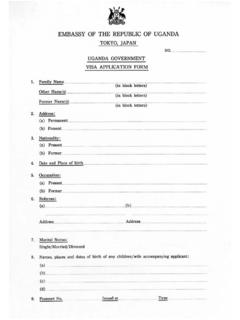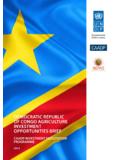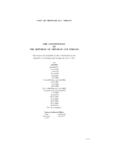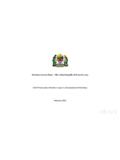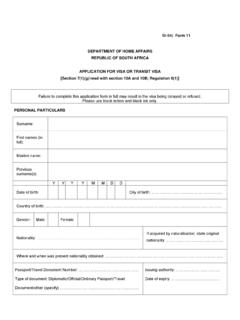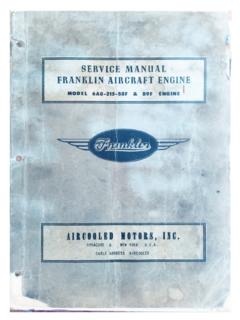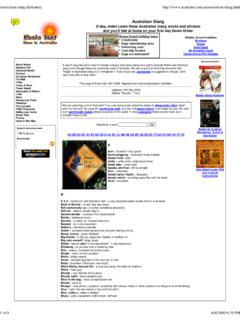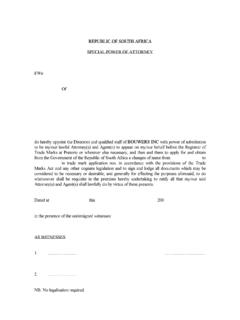Transcription of THE UNITED REPUBLIC OF TANZANIA - WHO
1 THE UNITED REPUBLIC OF TANZANIA . STANDARD TREATMENT GUIDELINES. AND ESSENTIAL MEDICINES LIST. MINISTRY OF HEALTH AND SOCIAL WELFARE. FOURTH EDITION. MAY, 2013. 1|Page FOREWORD. The Standard Treatment Guidelines (STG) and the National Essential Medicine List for TANZANIA (NEMLIT) was first published in 1991. The fourth edition includes new sections on symptoms and syndrome. The STGs have been updated and are consistent with current national guidelines for diagnosis and management of common diseases. The guidelines also reflect changes in the management of various diseases including asthma and hypertension following recommendations from WHO and experts from international medical associations and agencies. There have been improvements in the format of treatment regimens, showing more clearly the classification of medicines by level of health care within the treatment guidelines, and not just in the NEMLIT.
2 The STG and NEMLIT aims at providing health practitioners with standardized guidance in making decisions about appropriate health care for specific conditions found in TANZANIA . By using STGs, prescribing practices can be rationalized and patient outcomes can be improved while making optimum use of the limited resources for medicines. The NEMLIT attached to the STG retains its purpose of identifying medicines that are considered essential for the treatment of common disease conditions in TANZANIA . The medicine list is in line with the World Health Organization (WHO) recommendations under TANZANIA conditions. It follows the principles and concepts of essential medicines so as to simplify the management of medicines supply and support a streamlined logistics system. This set of tools is meant to be a guide for quick reference and its recommendations are valid for most presentations of the conditions covered.
3 Nevertheless, clinical judgment and experience will always prevail for adjustment of treatment in individual cases when necessary. This new edition of STGs provides Medicines and Therapeutics Committees (MTCs) at our health institutions an opportunity to strengthen their role in improving therapeutics and management of medicines in practice. MTCs are requested to promote the concepts of evidence based selection of medicines and cost-effective treatment protocols and facilitate STGs to be applied in their specific practice settings, translating and incorporating into local guidelines, formularies and in-service training programmes. The Ministry's policy is that all public and private health workers in TANZANIA will promote and adhere to these Standard Treatment Guidelines, and that prescribing, purchasing, labeling and dispensing of medicines should be by generic names as much as possible, and consistent with the level classification in the STGs and NEMLIT.
4 It is my hope that all health workers in TANZANIA will find this document a useful tool in management of patients' illinesses. Hon. Dr. Hussein Mwinyi (MP). MINISTER FOR HEALTH AND SOCIAL WELFARE. i|Page ACKNOWLEDGEMENTS. The Ministry of Health and Social Welfare greatly appreciates the support of the Health Sector Program Support IV in the course of development of the Standard Treatment Guidelines and Essential Medicines List. The Ministry expresses much gratitude to the World Health Organization (WHO) for providing the technical support in reviewing these guidelines and the Danish Internation Developments Agency (DANIDA) for the financial support. It is anticipated that, the guidelines will be useful as tools for health professionals. The Ministry wishes to acknowledge the following members of the the National Medicines and Therapeutic Committee (NMTC) for their valuable inputs, guidance and approval of the document: Dr.
5 Donan W. Mmbando Chief Medical Officer and Chaiperson of the NMTC. Mr. Henry Irunde Chief Pharmacist and Secretary of NMTC. Dr. Margaret E. Mhando Director, Curative Services MoHSW. Dr. Mohammed .A. Mohammed Director, Health Quality Assurance MoHSW. Dr John Rwegasha Consultant Physcian (Gastroenterologist) MNH. Dr. Daudi Mavura Consultant, Dermatologist - KCMC. Dr. Robert Mvungi Consultant Cardilogist MNH. Mr. Emmanuel Yohana Clinical Pharmacist, Mirembe Psychatric Hospital Mr. George Mlavwasi Head, Pharmacy Department MNH. Dr. Baraka Nzobo Dental officer, Morogoro Regional Hospital Dr. Charles Massambu Assistant Director, Diagnostics MoHSW. Dr. Doroth Kijugu Regional Medical Officer Singida Dr. Rodrick Kisenge Consultant Paediatrician MUHAS. Mr. Hiiti Sillo Director General, TFDA. Mr. Heri Mchunga Director Logistics- MSD. Prof. Mary Jande Pharmacologist - BUHAS. The preparation of the guidelines has been made possible by the contribution of a review group composed of multi-sectoral and interdisciplinary experts.
6 The Ministry acknowledges all those who were involved in the development of the document and appreciates a sincere contribution of: Mr. Hanif Nazerali Adviser Pharmaceuticals MoHSW. Dr. Linda Ezekiel Consultant, Renal Unit MNH. Ms. Siana Mapunjo Principal Pharmacist - MoHSW. Winna Shango Principal Pharmacist MoHSW. Ms. Anita Masenge Senior Pharmacist - MoHSW. Dr. Kapona Consultant Obstetric/Gynecologist- MNH. Dr. James Rwehabura Consultant Haematologist MNH. Dr. Edna Majaliwa Consultant Paediatrician MNH. ii | P a g e Dr. Dominista Kombe Medical Oncologist ORCI. Dr. Shaban Consultant Neurosurgeon MOI. Ms. Eva Muro Clinical Pharmacist KCMC. Dr. Sara Urassa Physcian KCMC. Dr. Gileard Masenga Obstetric/Gynecologist KCMC. Dr. Joyce Mugasa Psychiatrist MNH. Dr. Kitange Jamhuri Physcian Temeke Municipal Hospital Dr. Henri Swai ENT Surgeon Dr. Judith Mwende Paediatric Ophythamology MNH. Dr. Sira Owibingire Dental Surgeon MNH.
7 Dr. Sabas Kimboka Nutritionist TFNC. Dr. Neema Rajabu Physician - Mwananyamala Municipal Hospital Dr. Innocent Mwombeki Medical Officer, Mirembe Hospital Mr. Kitundu Principal Pharmacist MoHSW. Dr. Bernedetha R. Shillio Paediatric and Community Ophthalmogist MoHSW. Dr. Anath Rwebembera Paediatrician NACP. Dr. Allan Tarimo Medical Doctor- NTLP. Dr. Marero Medical Doctor NMCP. Ms. Albina Kirango Pharmacist- ORCI. Ms. Rachel Kaposwe Principal Nuring Officer RCH program Dr. Mcharo Cuthbert Orthopaedics MOI. Dr. Eppaphroditus Msambili Clinical Officer Bahi District Council Dr. Mashafi JM Consultant Obstetric/ Gynecologist - AGOTA. REGINA L. KIKULI. ACTING - PERMANENT SECRETARY. iii | P a g e HOW TO USE THE DOCUMENT. The guideline covers chapters of common diseases in TANZANIA . Most chapters start with a title, a brief description of the topic, common clinical signs and symptoms of each disease, the diagnosis and differentials, investigations, treatments and supportive care.
8 The document comprises the national Essential Medicines List (NEMLIT) which will be used in the public health facilities. The medicines will be used to treat the majority of public health problems and they should be available to health facilities at all time. The guideline also makes provision for referral of patients to higher health facilities. The indices for all medicines used are found at the back of the guide book, together with the information on how to report the adverse drug reactions. All health care workers are encouraged to report suspected adverse drugs reactions (ADR) when the reaction is potentially serious or clinically significant. The guideline also, makes provision for referral of patients to higher health facilities see the referral form. The last pages of the guideline contain annexes, references as well as the Essential Medicines List. It is important to remember that the recommended treatments provided in this document are evidence, clinically approved and are in consistent with the already existing WHO guidelines.
9 Comments that aim to improve these treatment guidelines will be appreciated all the time and the form for that purpose is appended. iv | P a g e TABLE OF CONTENTS. FOREWORD .. i ACKNOWLEDGMENT ..ii TABLE OF CONTENTS .. iv ABBREVIATIONS AND SYMBOLS .. xiv CHAPTER ONE .. 1. SYNDROMIC APPROACH .. 1. PAIN .. 1. HEADACHE .. 3. 7. COUGH .. 8. CONVULSION .. 8. SHOCK ..10. DEHYDRATION ..12. CHAPTER TWO ..17. ORAL AND DENTAL CONDITION ..17. 1. 0 PERIODONTAL CONDITIONS ..17. DENTAL CARIES ..19. ODONTOGENIC AND NON-ODONTOGENIC OROFACIAL INFECTIONS ..21. FUNGAL INFECTIONS ..27. VIRAL INFECTIONS ..28. APHTHOUS ULCERATION ..29. POST EXTRACTION BLEEDING ..30. v|Page TOOTH SENSITIVITIES ..31. TOOTH ERUPTION, SHEDDING AND EDENTULOUSNESS ..31. MALOCCLUSIONS ..32. TRAUMATIC DENTAL INJURIES ..33. TUMOURS AND TUMOUR-LIKE CONDITIONS OF ORAL CAVITY AND FACIAL REGION..34. CHAPTER THREE ..36. GASTRO INTESTINAL DISEASE CONDITION.
10 36. 1. 0 INFECTIONS OF GASTROINTESTINAL 2. 0 DISORDERS OF GASTROINTESTINAL TRACT ..50. DISORDERS OF THE LIVER AND BILLIARY TRACT ..65. CHAPTER FOUR ..36. RESPIRATORY DISEASE CONDITIONS ..71. ACUTE RESPIRATORY INFECTIONS (ARI) ..71. BRONCHOSPASM ..74. 3 0 BRONCHITIS ..78. CHRONIC OBSTRUCTIVE PULMONARY DISEASE ..79. OTHER RESPIRATORY INFECTIONS ..81. CHAPTER FIVE ..85. OBSTETRICAL/GYNAECOLOGICAL DISEASE CONDITIONS & CONTRACEPTION .85. INFECTION OF THE GENITAL-URINARY TACT ..85. ABORTION ..86. PREMATURE RAPTURE OF MEMBRANE ..87. PROPHYLAXIS FOR CAESARIAN SECTION ..88. NAUSEA AND VOMITING IN ANAEMIA DURING PREGNANCY ..89. vi | P a g e HYPERTENSION IN PREGNANCY ..90. DIABETES IN PREGNANCY ..93. HEART BURN IN PREGNANCY ..93. RESPIRATORY DISTRESS SYDROME ..94. STIMULATION OF LABOUR AND MYOMETRIAL RELAXATION ..94. TERMINATION OF PREGNANCY ..96. PREGNANCY AND LACTATION ..96. PELVIC INFLAMMATORY DISEASES ..96. HORMONAL CONTRACEPTION.










